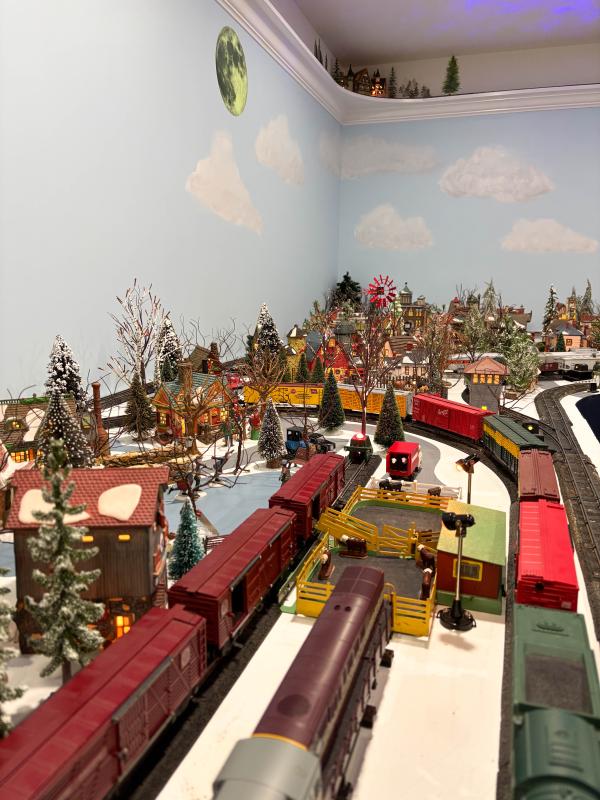Chugging along with Christmas cheer
Yellow and red gondolas float up and down the alpine mountain, overlooking the snow-covered village below. The silhouettes of people in houses glow through the windows as passenger and freight trains glide past in the dark purple hue of the artificial night.
Troy Witmer’s eyes light up as he shows off his carefully and intricately designed S-scale model train Christmas village display, which takes up an entire room in his Lewes basement.
The 61-year-old Dover native has been creating his own increasingly elaborate model train villages for nearly 50 years, and model trains have been a part of his life for as long as he can remember.
“It’s a world that I create, and I just get absorbed into it,” Witmer said.
The passion started with his grandfather, who passed it down to his father, who passed it down to him. He’s had a train display for every Christmas but one, when he was moving houses and was displaced for several months.
Each display contains hundreds of pieces, including figurines of people, animals, cars and other objects, and takes several months to make. Wiring the tracks for the nine trains, six of which can run simultaneously, is the most complicated – and frustrating – part, but Witmer doesn’t let that keep him from having fun and letting his imagination run wild in his designs.
When he first started creating these villages, he would put up and take down a new one every year.
But once he got his own house, his designs became increasingly complex, and now he leaves one up for two or three years at a time. When he gets tired of a layout, he takes it down and starts over.
“That’s the fun of it,” he said. “Creating these villages, these little whimsical scenes, is what I enjoy doing most.”
He bought his first piece, a model Dickens Village Thomas Kersey Coffee House, in 1986. Every year since, his family and friends have gifted him more and more pieces, expanding his collection.
The model ferris wheel, for example, was a gift from his college roommate. And the alpine village homes came from his sister, who lived in Germany for several years.
“I look at these things and think of those people,” Witmer said.
His collection also includes several of his father’s and grandfather’s original train cars and models from the 1950s, some of which, like the American Flyer train line, are no longer manufactured. His father’s model “Sam” the Semaphore Man, a figurine that causes the train to stop when it pops out of a door, can be seen in one part of the display.
Each little individual piece nestled into the larger picture – featuring a New England Village, Dickens Village, industrial and urban area, residential area and several steel bridges – adds its own quirk.
After Witmer gets home from work, he loves to sit and watch the trains run, letting his imagination bring the scenes to life.
“It’s just so relaxing to me,” he said.
He enjoys sharing the fun by inviting his neighbors, family and friends, young and old, to see his creations.
When kids come to see the displays, he doesn’t point out all the little details to them, eager for them to make those discoveries on their own.
On one train car, for example, is a model Rudolph the Reindeer with a glowing nose. Witmer said he loves waiting to see the kids’ excitement when they notice it.
Children aren’t the only ones who enjoy his displays, of course.
“One of the things that I think is so neat about it is people will come in, and it reminds them of something from their childhood,” he said. “Or some of the older folks will come in and say, ‘I had that very engine when I was a kid.’ I just love hearing those stories.”
He said he’ll never forget when he was a child, and an old neighbor, an elderly woman named Mrs. Tarburton, excitedly came over to see each of his creations.
“Every year, she couldn’t wait for me to get the trains done,” Witmer reminisced. “She would come down to the basement, and every time, she’d look and be like, ‘Oh my God, this should be in the newspaper.’ I’ll never forget her when I think about my trains.”
Ellen McIntyre is a reporter covering education and all things Dewey Beach. She graduated with a bachelor’s degree in journalism from Penn State - Schreyer Honors College in May 2024, then completed an internship writing for the Pittsburgh Post-Gazette. In 2023, she covered the Women’s World Cup in New Zealand as a freelancer for the Associated Press and saw her work published by outlets including The Washington Post and Fox Sports. Her variety of reporting experience covers crime and courts, investigations, politics and the arts. As a Hockessin, Delaware native, Ellen is happy to be back in her home state, though she enjoys traveling and learning about new cultures. She also loves live music, reading, hiking and spending time in nature.



























































